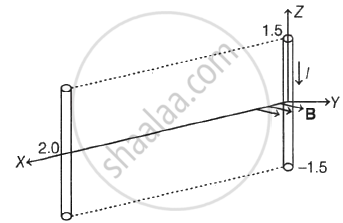Advertisements
Advertisements
प्रश्न
Prove that an ideal capacitor in an AC circuit does not dissipate power
उत्तर
In an AC circuit containing only an ideal capacitor, the current i leads the emf e by a phase angle of π/2 rad.
Here, for e = e0 sin wt, we have, i = i0 sin (ωt + π/2) Instantaneous power, P = ei
= (e0 sin ωt)[i0 (sin ωt cos π/2 + cos ωt sin π/2)]
= e0i0 sin ωt cos ωt as cos π/2 = 0 and sin π/2 = 1
Average power over one cycle, Pav
`= "work done in one cycle"/"time for one cycle"`
`= (int_0^"T" "P dt")/"T" = (int_0^"T" "e"_0"i"_0 sin omega"t" cos omega"t" "dt")/"T"`
`= ("e"_0"i"_0)/"T" = int_0^"T" sin omega"t" cos omega"t dt"`
Now, `int_0^"T" sin omega"t" cos omega"t dt" = 0`
∴ Pav = 0, i.e., the circuit does not dissipate power.
[Note: For reference, see the answer Q.6. The proof should be wriiten as part of the answer.]
APPEARS IN
संबंधित प्रश्न
Obtain an expression for average power dissipated in a purely resistive A.C. circult.
A resistor of 500 Ω and an inductance of 0.5 H are in series with an AC source which is given by V = `100 sqrt2` sin (1000 t). The power factor of the combination is ______.
In a series LCR circuit, the phase difference between the voltage and the current is 45°. Then the power factor will be ______.
Answer in brief.
What is wattles current?
When an AC source is connected to an ideal inductor show that the average power supplied by the source over a complete cycle is zero.
An AC circuit consists of only an inductor of inductance 2 H. If the current is represented by a sine wave of amplitude 0.25 A and frequency 60 Hz, calculate the effective potential difference across the inductor. (π = 3.142)
A 100 μF capacitor is charged with a 50 V source supply. Then source supply is removed and the capacitor is connected across an inductance, as a result of which 5A current flows through the inductance. Calculate the value of the inductance.
What is meant by wattles current?
L-C-R series circuit contains a resistance of 10 Ω and self-inductance 0.4 H connected in series with variable capacitor across 60 V and 50 Hz supply. The value of capacity at resonance will be π2 = 10.
An alternating e.m.f. of 0.2 V is applied across an LCR series circuit having R = 4 `Omega`, C = 80 µF and L = 200 mH. At resonance the voltage drop across the inductor is ____________.
In series 'LR' circuit and in series 'RC' circuit, same current is flowing. If the frequency of e.m.f. of a.c. is increased for both the circuits, the impedance will ____________.
In series LCR circuit, resistance is 18 `Omega` and impedance is 33 `Omega`. An r.m.s. voltage of 220 V is applied across the circuit. The true power consumed in a.c. circuit is ____________.
In LCR series circuit, an alternating e.m.f. 'e' and current 'i' are given by the equations e = 100 sin (100 t) volt,
`"i" = 100 "sin" (100"t" + pi/3)"mA"`.
The average power dissipated in the circuit will be ____________.
An e.m.f. E = E0 sin `omega`t is applied to a circuit containing 'L' and 'R' in series. If XL = R, then the power dissipated in the circuit is ____________.
The voltage gain of a CE amplifier is 50. A sinusoidal ac of amplitude 10 mV is applied as a signal. The output of the amplifier will be ______.
In a series LR circuit XL = R and power factor of the circuit is P1. When capacitor with capacitance C such that XL= XC is put in series, the power factor becomes P2. The ratio `"P"_1/"P"_2` is ______.
Two unknown resistances are connected in two gaps of a meter-bridge. The null point is obtained at 40 cm from left end. A 30 Ω resistance is connected in series with the smaller of the two resistances, the null point shifts by 20 cm to the right end. The value of smaller resistance Ω is ______.
A conductor lies along the Z-axis at −1.5 ≤ Z ≤ 1.5 m and carries a fixed current of 10.0 A in −az direction as (see figure). For a field B = 3.0 × 10−4`"e"^(−0.2"x")`ay T, find the power required to move the conductor at constant speed to x = 2.0 m, y = 0 in 5 × 10−3 s. Assume parallel motion along the x-axis.

What is the average value of alternating current over a complete cycle?
Explain the theory of an AC circuit with a resistor.
Where is the power dissipated in an alternating current circuit?
